Exploring the regional delights of Iranian gastronomy is a fascinating journey through the diverse culinary traditions and flavors found across different regions of Iran. Each region has unique dishes and ingredients reflecting local culture, climate, and geography.
In the northern regions, such as Gilan and Mazandaran, you’ll find a focus on seafood and rice-based dishes. The Caspian Sea provides abundant fresh fish, often prepared in flavorful stews and kebabs. Herbs, garlic, and citrus flavors are also prominent in this region.
Moving towards the west, you’ll encounter hearty and aromatic dishes in provinces like Kurdistan and Kermanshah. Lamb and poultry are commonly used, along with ingredients like saffron, dried fruits, and nuts. The cuisine of this region is known for its rich flavors and the use of spices like cinnamon and cardamom.
In the central regions, such as Isfahan and Yazd, you’ll discover a blend of traditional Persian flavours with influences from neighboring countries. The cuisine here is characterized by using ingredients like pomegranate, pistachios, and rosewater. Delicate rice dishes, succulent kebabs, and refreshing yogurt-based drinks are popular in this area.
Heading south to provinces like Khuzestan and Hormozgan, you’ll experience a vibrant and spicy culinary scene. Seafood, dates, and tropical fruits are abundant in this region. The cuisine is known for its bold flavors, with dishes often featuring a combination of spices like turmeric, cumin, and coriander.
Lastly, in the eastern provinces of Khorasan and Sistan-Baluchestan, you’ll encounter a cuisine influenced by neighbouring Afghanistan and Pakistan. Hearty stews, grilled meats, and flavorful rice dishes are common here. Using dried fruits, nuts, and aromatic spices like cardamom and cloves adds depth to the dishes.
Exploring the regional delights of Iranian gastronomy allows you to appreciate the diverse flavours, ingredients, and cooking techniques that make Iranian cuisine unique. It’s a culinary adventure that showcases the rich cultural heritage and culinary traditions of each region in Iran.

The Regional Delights of Iranian Gastronomy
Iranian gastronomy is renowned for its regional delights, each offering a unique culinary experience. Let’s explore some of the regional specialties that contribute to the diverse tapestry of Iranian cuisine:
- Gilan: Located in northern Iran, Gilan is known for its lush green landscapes and seafood-rich cuisine. Traditional dishes like Mirza Ghasemi (smoked eggplant and tomato dip) and Baghali Polo (rice with fava beans and dill) showcase the region’s love for fresh ingredients and vibrant flavors.
- Isfahan: Isfahan, a historical city in central Iran, is famous for its exquisite Persian sweets and delicate pastries. From the iconic Gaz (a nougat made with pistachios and rosewater) to the delicate Sohan (a saffron brittle), Isfahan’s sweet treats delight the senses.
- Tabriz: Located in the northwest, Tabriz is known for its hearty and flavorful cuisine. The region is famous for dishes like Koofteh Tabrizi (giant meatballs with a surprise filling) and Ash-e Doogh (a refreshing yogurt-based soup). Tabrizi cuisine often incorporates aromatic herbs and spices, creating a distinct and robust flavor profile.
- Kerman: Situated in the southeast, Kerman offers a taste of traditional Iranian desert cuisine. The region is known for its date-based sweets, such as Kolompeh (date-filled cookies) and Pashmak (Persian cotton candy). Kerman’s cuisine also features dishes like Sholeh Zard (saffron rice pudding) and Kebab-e Sultani (succulent grilled meat skewers).
- Khuzestan: Located in southwestern Iran, Khuzestan is known for its rich and spicy cuisine. The region’s signature dish, Ghalieh Mahi (spicy fish stew), showcases local ingredients like tamarind and fenugreek. Khuzestani cuisine also features dishes like Masgati (a saffron and rosewater jelly) and Falafel-e Ahvazi (crispy chickpea fritters).
These are just a few examples of the regional delights that make Iranian gastronomy so diverse and captivating. Each region brings unique flavours, ingredients, and culinary traditions, making Iranian cuisine a treasure.

The most delicious Iranian food
Iranian cuisine offers a wide range of delicious dishes that many love. Some of the most popular and delicious Iranian foods include:
- Chelo Kebab: This classic Iranian dish consists of succulent grilled kebabs, usually made with marinated lamb or chicken, served with saffron-infused rice and grilled tomatoes.
- Ghormeh Sabzi: A flavorful stew made with herbs, kidney beans, and tender chunks of meat (usually beef or lamb). It is typically served with steamed basmati rice and has a rich and aromatic taste.
- Zereshk Polo: A delightful rice dish made with saffron-infused rice, barberries (zereshk), and sometimes accompanied by tender chicken. The combination of sweet and tangy flavors makes it a favorite among Iranians.
- Fesenjan: A unique and delicious dish made with a rich sauce of ground walnuts and pomegranate molasses, cooked with chicken or duck. It has a sweet and tangy flavor that pairs perfectly with rice.
- Ash Reshteh: A hearty and flavorful Persian noodle soup made with various herbs, legumes, and noodles. It is often garnished with caramelized onions, fried mint, and a dollop of tangy yogurt.
- Baghali Polo: A fragrant rice dish cooked with dill and broad beans, often with tender lamb or chicken. Combining aromatic herbs and tender meat makes it a favorite for special occasions.
These are just a few examples of the delicious Iranian foods cherished by Iranians and enjoyed by people worldwide. Each dish has unique flavours and ingredients, reflecting the rich culinary heritage of Iran.

Traditional Iranian dishes
Traditional Iranian soup, or Aash, is a popular and delicious dish in Iranian cuisine. It is a thick and hearty soup that typically includes a variety of ingredients such as legumes, herbs, vegetables, and sometimes meat. Aash is known for its rich flavours and nutritious qualities.
One well-known type of Aash is “Aash-e Reshteh,” made with herbs, legumes, and noodles. It is often garnished with fried onions, mint, and a dollop of tangy yogurt. Another popular variety is “Aash-e Sholeh Ghalamkar,” which combines beans, herbs, and spices, creating a flavorful and aromatic soup.
Aash is not only enjoyed for its taste but also its cultural significance. It is often served during special occasions and celebrations, such as Nowruz (Iranian New Year). It brings people together and symbolizes unity and prosperity.
Preparing traditional Iranian Aash requires time and attention to detail, as each ingredient is carefully selected and cooked to create a harmonious blend of flavours. The result is a comforting and nourishing soup showcasing Iran’s culinary heritage.
Whether enjoyed on its own or accompanied by bread, Aash is a beloved dish that represents the rich culinary traditions of Iran and is cherished by Iranians and food enthusiasts worldwide.



















